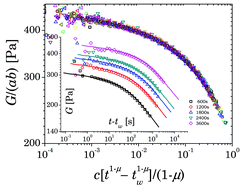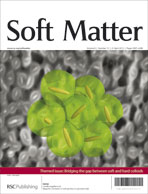Time temperature superposition in soft glassy materials
Abstract
Soft glassy materials are out of thermodynamic equilibrium and show a time dependent slowing down of the relaxation dynamics. Under such situations these materials follow a Boltzmann superposition principle only in the effective time domain, wherein time dependent relaxation processes are scaled by a constant relaxation time. In this work we extend the effective time framework to successfully demonstrate a time–temperature superposition of creep and stress relaxation data of a model soft glassy system comprised of a clay suspension. Such a superposition is possible when the average relaxation time of the material changes with time and temperature without affecting the shape of the spectrum. We show that variation in relaxation time as a function of temperature facilitates the prediction of a long and short time rheological behavior through the time–temperature superposition from the experiments carried out over experimentally accessible timescales.

- This article is part of the themed collection: Bridging the gap between soft and hard colloids

 Please wait while we load your content...
Please wait while we load your content...